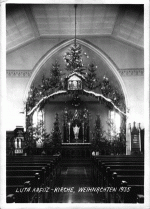In 1907, Rev. Gehrke accepted a call to become the missionary superintendent in western Canada. In 1907, Rev. L.F. Tank, Rev. Gehrke's brother-in-law, became the second pastor of the Church of the Cross. Under Rev. Tank, the parochial school was introduced. After several years it was discontinued because the operative costs were prohibitive. At this time, employment was very unstable. Wages were as low as 16 to 21 cents per hour and many of the members moved to farms and homesteads. Some migrated to the United States of America. Payments of existing debts were met with difficulty.
1911 the second son of the congregation was ordained, The Rev. Edward Schmok.
1914 the third son was ordained, The Rev. Rudolph Stelzer. In 1914, Lenten services were held at C.P.R. Weston shop to accommodate many church members.
In 1918 the church had 282 communicant members. Influenza epidemic forced all churches to close.
In 1919, Rev. Tank accepted a call to become the next missionary superintendent. In 1919, Rev. Eugene Poppen became the third pastor of the church. However, failing health compelled Rev. Poppen to terminate his work in Canada two years later.
Pastor P.B. Hack succeeded Rev. Poppen in 1919. The need for services in the English language became evident. Evening and Saturday classes were introduced to teach the essentials of the German language. Pastor H. Flattman, who had been secured for this work, fought a losing battle and classes were discontinued after two years. English services were then held occasionally.
Organists who served around 1919 were Frank Schneeberger, Mrs. Tank, Ida Schmok, Minnie Schneeberger, Mrs. Flathmann (also choir director from 1924-28), Mr. Kellner, Mrs. Hack, Mr. Beiner (March 1930 to May 1930), and Johann Krempin.
Various organizations emerged 1920 and prior, such as bible classes, Frauenverein, Naeh-Verein (seamstresses), Jugendverein, and choirs. Between 1933 to 1941 the Bathanien Verein (young people) developed. Since then, the "Brotherhood", the youngest and smallest organization of the congregation, provides the "Weekly Bulletin" and provides the "Membership Directory". The Brotherhood was affiliated with the Brotherhood of the American Lutheran Church. The Senior Young People was organized for those who were above the age of Luther Leaguers. Their chief purpose was to promote fellow-ships, especially among the younger people who were employed or in training in Winnipeg. The Luther League is the oldest organization. It is affiliated with the International Luther League of the American Lutheran Church, and endeavors to conduct a full program for young Lutherans as suggested by headquarters. The choirs were also organized around the 1920's. Two organized choir’s function annually in the congregation, namely:
The Junior and Senior Choirs. The Junior Choir trained young people in the appreciation of church music and offered an opportunity to participate in regular church services. The Senior Choir assists in beautifying the worship services.
In June 1921 bi-monthly English services were introduced for children speaking only English, held Sunday evenings. Also, Sunday School was being held at Weston C.P.R. Tower during the winter months.
In February 1922, special fund raising for the poor in Russia and at home in Canada. In May to June 1922, the church building was painted and the roof reshingled at a cost of $440.00. English services dropped due to poor attendance.
In 1923 the first typewriter was purchased. Offering envelopes were introduced. Fund raising for the poor continued.
1924 the congregations' fourth son was ordained, The Rev. Arthur Krempin. A tennis court was erected on the lot next to the church. Pastor Flatmann was hired to teach evening school.
An attempt to reinstate English services in 1925 was defeated. However, the fund for the poor was strongly supported.
Another attempt to re-instate English Services in 1926 was again defeated.
1927, debt owing to Ohio Synod stood at $8,970.00. Introduced Church Bank Account for use of cheques for accounts payable.
1928 Kindergarten classes were initiated. Evening schoolteacher Pauline Kissner had 57 students registered of which 45 attended regularly. Purchase of first house on William Avenue. $4,500.00 was borrowed from members for down payment and the balance was borrowed from the bank at 8%. Friederich Litowski lent money to pay mortgage off at 6%.
1929 German School teacher was hired by name of Kellner. However, discontinued in August due to poor attendance.
1930 marked the 25th anniversary year of the congregation. Years of hardships after World War I and the depression bred discontent and soon the differences in the congregation became marked and finally climaxed with the resignation of Pastor Hack and the loss of 60 members. 1930, the fifth pastor was installed and English services were now held regularly.
Rev. H. Honebein accepted a call to the remaining congregation of the Church of the Cross, which was still heavily indebted. The national depression of the 30's added to the already overburdened congregation.
1931 face lifting and church repairs were completed. English services again were started.
1932 the congregations' fifth son was ordained, The Rev. Edward Krempin. The windows in the church were redone.
1933 were the depression years. There were 112 paying members. 28 members were unable to contribute due to unemployment
1934 times were extremely difficult to meet payments. Pleas were made to the Ladies Aid, and special offerings were taken from each confirmed members to meet the budget. Even the Pastor forfeited a monthly wage.
1938 a new Hammond Organ, in the amount of $2,226.00, was purchased during a ten-month period - interest free. F. Rosplesch struck a deal with members that every tonne of coal purchased from his company; 50 cents would be a contribution towards the organ. A special meeting was held in August 1938, to inform members of outstanding eight mortgages, totaling $7,320.55. Payments were to be made over a period of ten months at 2%. Major repairs had again to be made on church building.
In 1944, the "Mary-Martha Mission Society" was organized and was affiliated with the Women's Missionary Federation of the American Lutheran Church. It promoted all the projects of the federation as well as local interests.
Pastor Honebein met the challenge and under his guidance, the congregation was not only able to fill its gaping ranks with new members but by 1946, on the 40th anniversary of the dedication of the church, was able to emerge from its strangling indebtedness.




